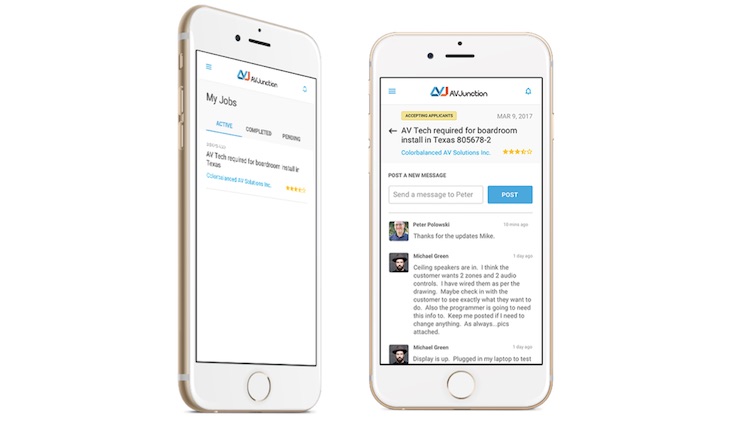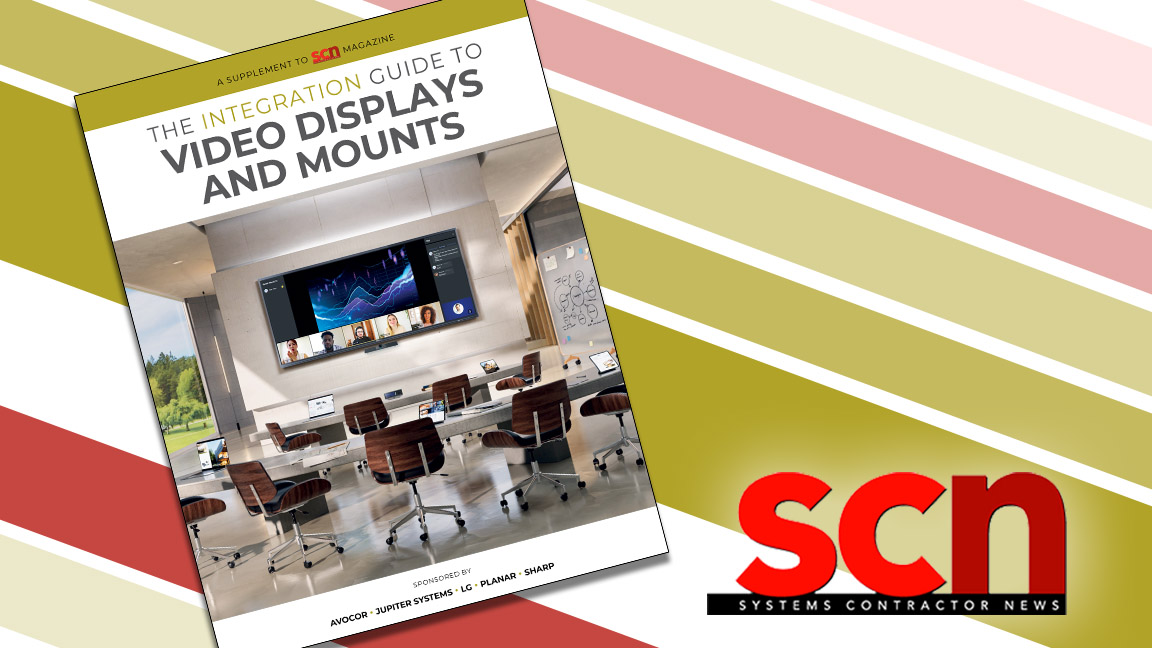AV Junction Aims to be the ‘Uber of Our Industry’
AV Junction is an online marketplace for AV talent where freelancers and integration firms can connect with one another to complete work. We caught up with founder and CEO Paul Weatherhead to learn more about this novel platform.

Launched this week, AV Junction is an online marketplace for AV talent where freelancers and integration firms can connect with one another to complete work. We caught up with founder and CEO Paul Weatherhead to learn more about this novel platform.

SCN: What was the inspiration behind creating AV Junction?
Paul Weatherhead: It was a combination of a few things. The first one was really my industry experience. I was working as a vice president of operations at an integrator out of Toronto. So I oversaw projects, project managers, technicians, and I was also heavily involved with hiring subcontractors and independent workers. And at times I found finding guys, managing them, and sorting out all of the administration things like payment and getting reports was a bit of a hassle—especially in remote and unfamiliar locations where we were doing more and more installations. And I found that the options out there like staffing agencies and my Rolodex only went so far. It was tough to find these guys and manage them, and I wanted a system that gave me—the buyer of services, so to speak—the autonomy to deal directly with the technicians and not overpay for them. And I really felt there was nothing out there.
And the other part to it was this whole rise of the “gig economy.” I was reading tons and tons of stuff about how by 2020, there’s reports that 40 percent of the North American workforce will be independent workers. And the advancement in technology has allowed this to happen. So I looked at other industries and websites such as Upwork and Freelancer.com, and I’m thinking, “OK, so in these spaces—web design and logo design, and arts-type industries—they’re doing it, they’re having these platforms.” So I thought, “Hey, in the AV industry, there’s a trend toward hiring subcontractors and freelancers, and why can’t we have a system specific to our industry?” So those were the two driving factors.
And I knew a ton of freelancers out there that I had had relationships with that were really talented guys, and I’m thinking “How do I connect these guys to get them more jobs and really make that match together?” and do it in such a way that creates some sort of standard, some kind of systemized way to help our industry out.
SCN: How is the launch going? How many members and freelancers have joined so far?
PW: This week was our official launch for our beta version, our Version 1. We did have a pre-registration run for the last month or so. So my team here was actively on social media and promoting and getting people to preregister, and that was very successful. Now that we have features available, the ability to do much more than just create your profile, I see the registrations increasing.
A daily selection of the top stories for AV integrators, resellers and consultants. Sign up below.
Right now we have about a few hundred freelancers, and that’s just from our pre-registration alone. It’s been quite a journey to get here—working on this for the last year seriously. I think there’s some good buzz around the place, and it will take a little bit to get everything going and get people used to it. But, all the reception I’ve had has been positive, so it’s very exciting right now.
SCN: In which geographies and verticals do you expect the platform to get the most use?
PW: Our platform is supported in 25 countries. And I anticipate North America and Europe to have the highest levels of use; those are the two areas that we’re really focused on. I’ll be exhibiting with my team at ISE in Amsterdam in February and we’ll be exhibiting at InfoComm as well. So two major trade shows there that should give us a nice boost.
In terms of verticals, my background is more in the integration side. At my previous company we did have a rental and staging side as well. But I do see live events and rental and staging being the first [verticals to gain traction]. All the conversations I’ve had with freelancers in those areas, it feels like that’s where we’re going to get the start of the traction going, followed by corporate.
SCN: Do you plan on adding integration with any industry-specific business management software?
PW: Certainly, yeah—never say never, really. My goal with AV Junction was to help our industry, and I don’t think there’s many solutions out there that can match companies and freelancers together with profiles and ratings, and those types of things. One thing one of my coworkers said was, “Know when your products and services start and know when it ends.” So I take this to heart and I don’t want to do too much, but if there’s platforms out there that can complement the AV Junction services, I’m open ears to that. And being new and being a startup, the user feedback is extremely important to us. I want to make sure we’re delivering the best possible service, and if there’s specific things that we can integrate, then I’m open to do that.
SCN: How does the verification process work?
PW: So how the verification process works is either you’re verified or you’re not verified. And we take verification very seriously. One of the big focus points from our conversations with AV companies was this overarching focus on the quality of technicians. And we as AV Junction want to ensure that what people are saying about themselves is true.
So when a freelancer registers, they’re automatically pre-screened. Their profile isn’t public in our database. One of the members of our team has a look at it and makes sure they’re AV specific; we look for spam and all of those visual indicators. And essentially, once pre-screened, they’ll become public in our database. Then we have a verified button on their profile. So if they want to get verified, we have a three-step process.
The first step is that the profile has to be filled out, and there has to be a minimum of three AV industry certifications: CTS or anything from AVIXA/InfoComm is an area that we’re looking for, but also programmers—if they’re Crestron or Extron certified—those are the certifications we’re looking for. A minimum of three years experience is a must. So once they have their profile filled out, we ask them to actually email us to provide us with references from outside employers; a link to their LinkedIn profile, which we then cross-check; and we ask for a latest resume, if available. Once we’ve established that, we get on a phone interview with them, and we get live feedback from them once we’ve figured out all of our cross-referencing. And then an ongoing check is that they must uphold a certain rating on our system. So after a freelancer’s hired on our system, the AV company rates that freelancer, so we have a threshold rating there.
So we do take it very seriously. We are a marketplace, so we try to attract the best, but we also try to heavily vet and filter those freelancers as well.
Another thing: I know AVIXA has introduced these digital badges, and in the next version [of AV Junction], which is coming shortly, we’ll be introducing digital badges to profiles. And what they do is they send an API signal back to the accreditation company—let’s say [AVIXA]—and they reference a few things, like their name, just to make sure they have that certification.
SCN: How does the hiring process work, in terms of helping freelancers get acquainted with employers and the work they’re contracted to perform?
PW: So we help make the connection and we provide the tools to ensure a successful working relationship. The actual contract is between the buyer of services (the AV company) and the seller of services. So the first part is both AV companies and freelancers have profiles, so both can view each other and determine their fit. There are ratings on both sides, the size of the company, the certifications of the freelancers, the experiences—all of that plays a factor.
And the way our system works is there needs to be a job posting. So this is done by the AV company. So they might need an installation technician specializing in video walls for a week. So that job posting includes details like location, start date, job summary, scope of work (there is a difference between job summary and scope of work), and specific technician requirements. So it’s quite specific. And we also have these skill tags as well, and everything is keyword-search optimized.
Once that job posting has been published, we make it public to our database. So AV companies can receive quotes from freelancers, either by a freelancer finding their post from a search based on their location or the key searches they’re skilled in—let’s say video wall—or the AV company can proactively go and look for freelancers in the database, in the location with those skills, and invite them to quote them on a job. And this is a key thing: I find that receiving more quotes increases the chances of more negotiations, and the AV company or the project manager setting it up remaining under budget. That was a key thing that I had difficulty with in my experience; we really try to make that quoting and negotiation really quite simple.
Moving forward, once an AV company and freelancer have agreed on a price, a work order is created. So all hires have work orders. For me this is a big sticking point: work orders are the foundation of a good working relationship, so the scope’s properly defined; payment terms and milestones are set; reporting requirements are set. It gives the project a solid base to start from, because it can be a complete mess otherwise. So they agree to this work order, and then the work is performed.
In order to ensure work is done, we have milestone payments set up, but we also provide a centralized progress update tool. So the freelancer has a centralized place to send updates, attach progress pictures, send documentation back and forth—whether it be commissioning documents, specs, or drawings. It also provides good backup documentation to show the work’s been done.
And then as the work as done and milestones are reached, the freelancer clicks “invoice,” the AV company approves payment or goes back to the freelancer for rework or whatever the issue might be.
SCN: What’s your long-term vision for AV Junction?
PW: This version is version 1, and it’s going to be a version of many. We’ve got a solid roadmap of additional features we want to add, and we’re also going to take user feedback so we can tweak the system.
But if I look out six months or a year from now, I really see AV Junction becoming a central hub of the AV industry; a platform that AV professionals can trust, that has integrity, that puts its users first to deliver the best experience—and a valuable one. I’ll go so far as to say I want to be the Uber or the Upwork of our industry. We want to provide immense value, but most importantly making it easier than ever to put AV professionals in the hands of those who need them, and to provide job opportunities for the AV freelancers who possess those skills.
So AV junction is for everyone—industry veterans, up-and-coming talent—it’s a gateway to more opportunities. And I almost see AV professionals asking one another “What’s your AV Junction rating?” I’d love to see that in the future as well.
Matt Pruznick is the former editor of AV Technology, and senior editor for Systems Contractor News and Residential Systems. He is based in New York.

